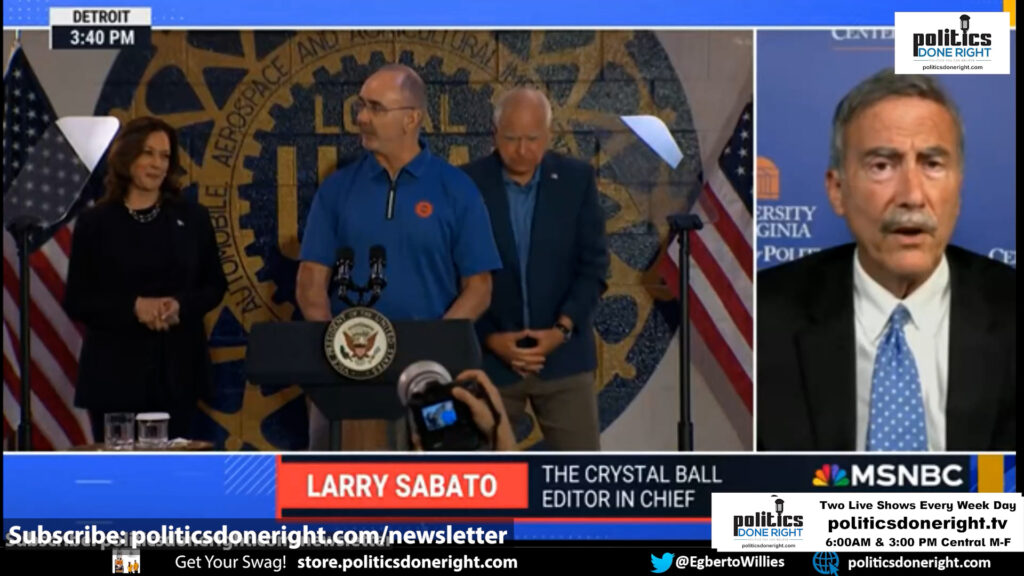Political Analyst Larry Sabato revealed that VP Kamala Harris has momentum, reflected in the polls, including the swing states.
Analyst Larry Sabato confirms VP Kamala Harris’ momentum.
Podcasts (Video — Audio)
In American politics, momentum plays a substantial role. As Vice President Kamala Harris solidifies her campaign, recent analyses, including those by renowned political analyst Larry Sabato, suggest that her campaign is gaining traction and may soon break away from the statistical ties that have defined the race so far. Sabato’s insights, particularly from his respected Crystal Ball reports, indicate that Harris is on the brink of achieving a lead beyond the margin of error—a significant development in an election that could reshape the nation’s future.
Sabato’s assessment of the current political landscape underscores the seismic shift in momentum that Harris has generated in just a few weeks. His analysis, rooted in state-by-state polling and electoral forecasts, points to a noticeable change in crucial battleground states such as Georgia and temporarily problematic states like New Hampshire and Minnesota. Once considered contentious, these states are now showing signs of leaning towards Harris, thanks to her energetic campaigning and the strategic alliances she’s forged, particularly with her running mate, Governor Tim Walz.
The significance of this shift cannot be overstated. For months, the political narrative had been cautious optimism among Democrats and simmering anxiety among Republicans. President Joe Biden’s earlier performances in the debates and the lingering effects of his administration’s challenges had left the Democratic base uncertain. However, Harris’s entrance into the race has invigorated the Democratic electorate, particularly among young voters, women, and minorities—groups pivotal for any successful Democratic campaign.
Sabato’s analysis reflects a broader trend that many political observers have noted: the so-called “enthusiasm gap” is narrowing. Harris’s ability to mobilize key demographics, particularly college-educated white males and young voters, has been crucial. Her campaign’s focus on reproductive rights, climate change, and economic justice resonates deeply with these groups, which had previously been less enthusiastic about the Biden-Harris administration.
The impact of this momentum is particularly evident in states like Arizona and Georgia. According to recent polls, in Arizona, where President Biden struggled to gain a consistent lead in the 2020 election, Harris is now showing a clear advantage. This shift is partly attributed to the extreme positions of Republican candidates like Kari Lake, whose polarizing rhetoric has alienated moderate voters. Similarly, in Georgia, a state that has been red for years, Harris’s campaign has moved the needle towards a tie, a remarkable feat in a state that has been trending purple for some cycles.
One of the most intriguing aspects of Sabato’s analysis is his focus on the “reverse coattail” effect. In states like North Carolina and Arizona, where far-right Republican candidates are on the ballot, there is a growing concern among GOP strategists that these candidates may drag down the entire ticket. This phenomenon could benefit Harris, as disillusioned moderate Republicans and independents might opt for a more centrist option rather than align themselves with candidates they perceive as too extreme.
Moreover, Sabato’s remarks on the potential post-DNC bump for Harris are particularly insightful. Historically, national conventions have provided candidates with a temporary poll surge. Still, Sabato suggests that Harris’s bump could be more enduring, especially if the convention is well-executed and devoid of the controversies that plagued past Democratic gatherings. A successful convention could propel Harris out of the statistical tie and into a lead beyond the margin of error, solidifying her position as the frontrunner in the race.
Harris’s poll rise also reflects a broader cultural and moral awakening among the American electorate. The Trump era, characterized by divisive rhetoric and morally questionable actions, has left many Americans yearning to return to decency and integrity in leadership. Harris, with her commitment to progressive values and her ability to articulate a vision of an inclusive and just America, offers a stark contrast to her predecessor’s chaotic and often morally ambiguous legacy.
This shift in public sentiment is not just a rejection of Trump’s brand of politics but also an affirmation of the values that Harris represents. Her campaign has tapped into the collective desire for competent and compassionate leadership. This leadership recognizes the struggles of everyday Americans and is committed to addressing systemic inequalities.
Larry Sabato’s analysis offers a compelling narrative of Vice President Kamala Harris’s campaign. Her momentum, fueled by strategic campaigning, demographic shifts, and a broader cultural awakening, has positioned her as a formidable contender in the 2024 election. As the race progresses, it will be crucial to watch how this momentum translates into tangible electoral gains, particularly in key battleground states. If Sabato’s predictions hold, Harris could achieve an out-of-margin-of-error lead, setting the stage for a historic victory in November.

